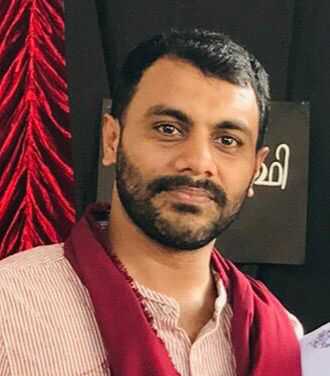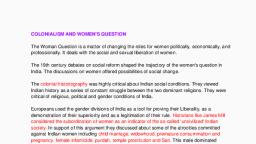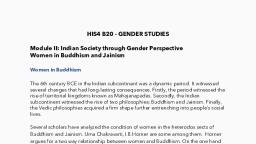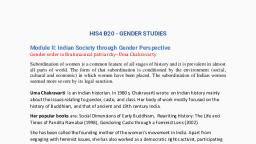Page 1 :
HIS4 B20 - GENDER STUDIES, Module II: Indian Society through Gender Perspective, Medieval Islamic law and women- rights of women in marriage and inheritance- women in royal, courts- life in Mugal harem- cuncubinage- marginalised women- slave girls, The attitude towards women and her position in society was different according to society,, region, rulers, socio-economic position of women in a society, etc. So, we cannot reach into a, generalization and a general statement about the position of women in Indian society especially, in Medieval period., The position of women within the Indian society underwent transformations within the Mughal, period. The evolvement of social laws and customs, brought about changes within the aspects,, which depicted improvements in the status of women. The intellectual culture of women varied, in accordance to the class., In rural areas, women were residing mostly in backward conditions and there was not any room, that would promote their cultural and social development. The rural women were primarily, occupied with their family responsibilities. In most cases, they were engaged in agricultural and, farming practices, implement household chores, took care of the needs and requirements of their, family members and got engaged in some recreational and leisure activities. The women, belonging to upper classes got involved in enhancing their skills and abilities. They also got, enrolled into educational institutions and training centres to acquire education, Social Position: During the medieval India, the social movement of Indian women, was restricted. They were prohibited to attend public functions and were not free to participate as, men’s equals in religious functions. Similarly, most of the women were made to believe that, their ideal place was the home. Thus, they were persuaded by circumstances to accept their, inferiority and secondary position. Men being providers, women became dependent on them, economically for their subsistence except for the labour classes, where both men and women, participated in subsistence farming and other occupations., The economic position of the Mughal royal women was very powerful and they engaged in, charity as well as patronized arts like music and dance. The women of middle and lower classes, had a tougher time., Though, the overall position of woman in Mughal period was low, there were many Hindu and, Muslim woman of outstanding ability, whose fame is still relevant today like, notably Rani, Durgawati of Gondwana, Rani Karmawati, Mira Bai, Tarabai, etc. Among the Muslim woman in, Mughal Period, Nur Jahan, Mumtaz, Chand Bibi, Jahanara, Raushanara, Zeb-unnisa, etc. played, an important part in the affairs of that time., Women in Politics: During the Mughal period there were some very learned women who made, unique contribution to the development of literature. Razia Sultana occupied the throne of Delhi, from 1236 to 1240. Nur Jahan and Jahan Ara took an active part in the state affairs. Nur Jahan
Page 2 :
was the greatest Muslim queen of India. She was the very embodiment of beauty and military, valour. Mumtaz Mahal a princess of a rare beauty combined with superb intellectual talents and, aesthetic tastes who involved in politics. Chand Bibi, daughter of Husain Nizam Sahs,, Ahmadnagar, took the leadership of Ahmadnagar and made a gallant and successful resistance, to the Mughal army., Bhakti movements which flourished during the medieval age gave rise to a new class of man, and women who cared little for gender bias. This liberal stream to some extent widened the, horizon of women. Female poet-saints also played a significant role in the Bhakti movement., Nonetheless, many of these women had to struggle for acceptance within the largely male, dominated movement. Injustices and the patriarchal order itself were not a major focus of these, poet-saints., Social Problems faced by Women during medieval period:, a) Practice of Child Marriage, Though the practice of child marriage had emerged during ancient period. They married young,, had many children, and worked as domestic servants of the rich. These child brides were denied, all intellectual, physical, and spiritual development., b) Prohibition of Widow Remarriage, The condition of the Hindu widows became more miserable during the medieval period. Rigidity, of caste system denied them the right to freedom and social mobility. A widow was secluded, from society and was devoid of any worldly pleasure. Dharmasastras strictly prohibited the, widow remarriages. The glorification of the ideal of ‘Patibrataa’ was another hurdle in the path, of widow remarriage. Child widows had a miserable life. They were denied education, public life, and most of the religious activities were tabooed for them. Their very presence on important, occasions was considered to be disgraceful for they were treated as a symbol of illomen. They, were made to work like servants throughout their lives., The condition of the Muslim widow was slightly better owing to the fact that she could marry, after a certain lapse of time following her husband’s death., c) Practice of Sati, Sati system was pervasive among hindu community. Mughal rulers like Akbar, Jahangir and, Aurangajeb tried and issued orders to prohibit the practice of sati but it could not be suppressed., In 1582, Akbar issued an order to prevent any use of compulsion in sati., , However the Muslim woman had some distinct advantages. After the death of her husband, she, was allowed to remarry, after waiting for a period of three months which was called “iddat”., ‘Jauhar System’ refers to the practice of voluntary immolation by wives and daughters of, defeated warriors, in order to avoid capture and consequent molestation by the enemy. The, practice was followed by the wives of defeated Rajput rulers.
Page 3 :
d) Purdah System, Purdah system refers to the practice of women wearing a gown or veil to cover their face and, upper part of the body. It was a common practice among the Muslims in Medieval, India. It was existed among Kshatriyas in the period of Dharma Sastras. Purdah gained, popularity with the advent of the Muslims. The Purdah system was a part of Mughal culture and, this system was observed strictly during Mughal period. Girls were not allowed to go outside., Arrangements for education of princesses were made in the palace. As in Hindu society,, similarly among the Muslims, rich people used to arrange for education of their girls in their own, homes. Music was taught to princess in the palace by carefully selected ustads (teachers)., The Muslims woman observed purdah much more strictly than, the Hindus, e) Polygamy, Polygamous marriages were common in Medieval India., This practice was prevalent among the warrior communities and the wealthy merchant class. In, ancient India, this practice was influenced by various factors, these were personal opinion of the, individuals, status symbol and social, moral and religious obligation. Marriage in traditional, Hinduism was primarily meant for progeny and implementation of duties and, responsibilities. Apart from the performance of household responsibilities, the spouses made, provision of support and assistance to each other., g) Devadas System, The Devadasi system was prevalent among the Hindus. Under the Devadasi system women, were the brides of gods. But they were supposed to entertain kings, priests, and even members of, the upper classes. These Devadasis were supposed to live the life of celibacy. All the, requirements of Devadasis were fulfilled by the grants given to the temples. In temple they used, to spend their time in worship of god and by singing and dancing for the god. Some kings used to, invite temple dancers to perform at their court for the pleasure of courtiers., h) Female Infanticide, Female infanticide is referred to the killing of the girl child, after she has been born. Right from, the time of birth, the girl child was considered as a liability by her parents., It was believed that she would only make demands and would yield no returns upon investment., When the girls got married and went to their marital homes, then parents, normally possessed the viewpoint that they have to, eventually get married, therefore, resources should not be, spend upon them. With the prevalence of this viewpoint,, they are deprived from the acquisition of education. The, poverty stricken and marginalized families also deprive, them from obtaining other materials such as, good clothes,, food etc. Hence, it can be stated that girls were neglected, at each state of their lives. At the time of marriage, huge, dowry demands were made, hence in order to prevent, these problems, preference was given to male children. It, was believed that male children would bring cash,, jewellery and other items as dowry. These are the major
Page 4 :
causes that led to prevalence of the practice of female, infanticide., The practice of female infanticide was common among certain, castes and tribes in India, especially in the north and northwestern, states. This practice was particularly prominent among, the communities, which normally experience problems and, difficulties in finding suitable matches for their daughters. When, the daughters were unmarried, it was regarded as a degradation, and dishonour for the family. The poverty stricken families or the, individuals, belonging to deprived and economically weaker, sections of the society normally did not possess adequate, financial resources, hence, fulfilment of the dowry demands is, regarded as a major problem for them., Dowry system was a common phenomenon. It actually meant “Stridhana” which included gifts,, ornaments, property, and cash presented to her by her father or her relatives. But in the, medieval period the term acquired special significance. The Hindus and Muslims favoured this, custom of dowry. This in a way contributed to female infanticide, as it became a heavy, burden on the poor. The birth of girls came to be seen as a misfortune by the majority of the, population., f) Women Education, Generally female education was restricted but the possibility was varied to different groups., Women from royal or high class familes got education while lower class women restricted to get, education. Muslim women generally got religious education., The girls of Medieval India, specially Hindu society were not given formal education. They were, given education related to household chores. On the other hand, in Muslim society, some of the, monarchs established separate schools for girls, as Akbar had done. Tutors were, appointed for exercises in the fine arts. Some of the learned women were themselves patrons of, learning, as – Sultana Raziya, Gulbadan Begum(Babur’s daughter), Salima Sultana(another, daughter of Babur), Mohan Anaga(Akbar’s foster mother), Nurjahan, Mumtaz mahal etc., , Women in royal courts- life in Mugal harem: The concubinage- marginalised womenslave girls, Concubine is (in polygamous societies) a woman who lives with a man but has lower status than his, wife or wives, , The Mughal nobles received salaries which were extremely high by any standards. There, expenses were also very high. They maintained a large train of servants and attendants and a, large stable of horses, elephants etc. Many of them maintained a large harem of women. Akbar, the illustrious Mughal emperor, maintained a Harem (seraglio) in which there were 5000 women,, and it had a separate staff of women officers who looked after its management. Mughal nobles, maintained number of concubines in their Harems. Sir Thomas Coryate writing that emperor, Jahangir “keep a thousand women for his own body.”
Page 5 :
In Mughal period the concubines and favorite slave girls led a pleasant life. They spent their time, in decking their beautiful person and in displaying or increasing their powers of fascination. To, become the favourite woman was their highest ambition. A favorite woman lived in splendor,, while a woman who displeased the master might even be killed., Many prisoners of war entered the harem. Slaves were also bought as, concubines. The women did not stay in perpetuity inside the harem and many, retired after death of each successive emperor., Akbar made some regulations so that the services of prostitutes might not be available very, easily to the public. The prostitutes were confined to a place outside the capital city. The nobles, followed the king’s example and spent lavishly on mistresses and dancing girls. The Governors, fill and adorn their mahals with beautiful women and seem to have the pleasure house of the, whole world within their walls., A special position was accorded to the emperor’s mother and chief wife with more importance, given to the former. Even foster mothers were given a position of importance. The rulers also, gave sisters preferential treatment. There would be a Padshah Begum, which was normally the, chief wife, except in case of Jahanara, who got the title on her mother’s demise and held it even, in Aurangzeb’s rule., Harem Employees, As for any other huge organisation, the harem too needed rules and regulations for smooth, functioning. Akbar was the first emperor to lay down rules for it and turn it into an institution., The harem was called mahal and the chief officer of the harem was called Nazir e Mahal (incharge of women quarters) and normally a khwaja sara or eunuch. All the harem officers would, be women or eunuchs. Ladies from very respectable and noble families, would be given the post of daroghas (supervising officers). Nur Jahan’s mother Asmat begum, was a Darogha so one can imagine the prestige involved., Dancing Girls, A large number of girls were attached to the Mughal courts for dancing and singing. The Mughal, kings were great patrons of fine arts of music and dance, which flourished during their regime., Many a time the prostitutes were employed as dancers and singers in public social and religious, functions. Some of them were highly accomplished ladies, adept in various arts and skills such, as music, poetry, sorcery and spying. The Rajput states had employed the services of some of, these public women for singing and dancing in the royal courts. Some others were fortunate, enough in attracting the attention of the princes perhaps because of the unusual beauty or their, exceptional accomplishment in some arts, and were accepted by the princes in their harem. They, lived there as the concubines and enjoyed a privileged position. A few of them were very loyal to, the king, even going to the length of burning themselves to ashes after the death of their kings., Women even accompanied the Mughal army and moved with them from place to place for the, entertainment of the, army personnel. Anarkali, Lal Kunwar, Nur Bai were some of the famous dancers of the, medieval time


















































